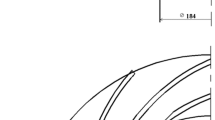Abstract
Investigation an efficient shape optimization method for centrifugal pump and other turbo-machine is significant to reduce time consumption of process and increase accuracy and modification. For analysis an efficient shape optimization procedure, slurry flow in centrifugal pump is investigated. Since a centrifugal water pump has been not designed to carry out slurry flows, its performance decreases and energy consumption of this kind of pump increases. Therefore, improvement of performance and reduction of energy consumed for these pumps are the major issues. Since the performance of a centrifugal pump strictly depends on its impeller shape, in this study, the shape of impeller was optimized in order to achieve a higher efficiency for slurry flow. To optimize the impeller geometry and to improve the performance of Berkeh 32–160 pump as for the case study, Artificial Neural Networks (ANN) and Eagle Strategy (ES) algorithms have been coupled with a validated 3D Navier–Stokes equations for two phase flow based on Eulerian-Eulerian model. In the next step, the pump experimentally tested in an established slurry flow test rig in laboratory. Measured data were used to verify the numerical results of initial pump with slurry flow. Finally, the complete numerical characteristic curves of the pump with the optimized impeller were compared to the validated numerical characteristic curves of that with the initial impeller to verify optimization. An efficiency improvement of 3.33% at only 9.9% increasing of head has been obtained for optimized geometry. The results indicated a reasonable improvement in the optimal design of pump impeller and a higher performance using the ES algorithm. Furthermore the ES and PSO algorithm was compared and results shows that ES is efficient than PSO algorithm in this application and this methodology is more efficient than other surrogate methods.




















Similar content being viewed by others
References
Anderson JD (1995) Computational fluid dynamics. McGraw-Hill, New york, pp 37–82
Bendell T (1988) Taguchi methods. In: Proceedings of the 1988 European conference on Taguchi method. Elsevier, Amsterdam, pp 13–14
Demeulenaere A, Hirsch C (2004) Application of multipoint optimization to the design of turbo machinery blades. ASME Turbo Expo 2004: Power for land, sea, and air. ASME, Vienna
Derakhshan S, Kasaeian N (2014) Optimization, numerical and experimental study of a propeller pump as turbine. ASME J Energy Resour Technol 136(1):012005-1-9
Derakhshan S, Pourmahdavi M (2012) Optimal design of centrifugal pump impellers. 4th International conference on computational methods (ICCM); Gold Coast (Australia)
Derakhshan S, Mohammadi B, Nourbakhsh A (2008) Incomplete sensitivities for 3D radial turbomachinery blade optimization. Comput Fluids 37(10):1354–1363
Derakhshan S, Pourmahdavi M, Abdolahnejad E, Reihani A, Ojaghi A (2013) Numerical shape optimization of a centrifugal pump impeller using artificial bee colony algorithm. Comput Fluids 81:145–151
Derakhshan S, Tavaziani A, Kasaeian N (2015) Numerical shape optimization of a wind turbine blades using artificial bee colony algorithm. ASME J Energy Resour Technol 137(5):051210-1-12
Derakhshan S, Riahi F, Bashiri M (2017) Efficiency improvement of a rotary gas separator by parametric study and gas/liquid-flow analysis. Soc Pet Eng. https://doi.org/10.2118/187966-PA
Emmanuel Nicholas P, Padmanban KP, Vasudevan D, Ramachandran T (2015) Stacking sequence optimization of horizontal axis wind turbine blade using FEA, ANN and GA. Struct Multidiscip Optim 52(4):791–801
Ergun S (1952) Fluid flow through packed columns. J Chem Eng Prog 48:89–94
Gandomi AH, Yang X-S, Talatahari S, Deb S (2012) Coupled eagle strategy and differential evolution for unconstrained and constrained global optimization. Comput Math Appl 63(1):191–200
Gidaspow D, Bezburuah R, Ding J, editors. (1992) Hydrodynamics of circulating fluidized beds, kinetic theory approach. Proceedings of the 7th Engineering Foundation Conference on Fluidization; New York
Gugau M. (2003) Transient impeller-volute interaction in a centrifugal pump: Technich univesitat Darmstadt, FG turbo machine and fluid antriebstechni
Lun CKK, Savage SB, Jeffrey DJ (1984) Chepurni. Kinetic theories for granular flow: inelastic particle in Couette flow and slightly inelastic particles in a general flow field. J Fluid Mech 140:233–256
Nelder JA, Mead RA (1965) Simplex method for function minimization. Comput J 7:308–313
Nourbakhsh A, Safikhani H, Derakhshan S (2011) The comparison of multi-objective particle swarm optimization and NSGA II algorithm: applications in centrifugal pumps. Eng Optim 43(10):1095–1113
Samad A, Kim KY (2008) Multi-objective optimization of an axial compressor blade. J Mech Sci Technol 22(5):999–1007
Song W, Keane AJ (2005) An efficient evolutionary optimisation framework applied to turbine blade firtree root local profiles. Struct Multidiscip Optim 29(5):382–390
Svozil D, KvasniEka V, Pospichal J (1997) Introduction to multi-layer feed-forward neural networks. Chemom Intell Lab Syst 39:43–62
Talatahari S, Gandomi AH, Yang X-S, Deb S (2015) Optimum design of frame structures using the eagle strategy with differential evolution. Eng Struct 91:16–25
Versteeg HK, Malalasekera W (1995) An introduction to computational fluid dynamics: the finite volume approach. Longman Scientific & Technical, Harlow
Wen CY, Yu YH (1966) Mechanics of fluidization. Chem Eng Prog Symp Ser 162:100–111
Yang X-S, Deb S (2010) Strategy using Lévy walk and firefly algorithms for stochastic optimization. Nature inspired cooperative strategies for optimization. 284. Springer, Berlin Heidelberg, pp 101–111
Yang X-S, Deb S (2012) Two-stage eagle strategy with differential evolution. Int J Bio-Inspired Computation 4(1):1–4
Yu K, Yang X, Yue Z (2011) Aerodynamic and heat transfer design optimization of internally cooling turbine blade based different surrogate models. Struct Multidiscip Optim 44(1):75–83
Author information
Authors and Affiliations
Corresponding author
Rights and permissions
About this article
Cite this article
Derakhshan, S., Bashiri, M. Investigation of an efficient shape optimization procedure for centrifugal pump impeller using eagle strategy algorithm and ANN (case study: slurry flow). Struct Multidisc Optim 58, 459–473 (2018). https://doi.org/10.1007/s00158-018-1897-3
Received:
Revised:
Accepted:
Published:
Issue Date:
DOI: https://doi.org/10.1007/s00158-018-1897-3




